Taylor 142 User Manual

OPERATOR’S
MANUAL
Model 142
Soft Serve Freezer
Original Operating Instructions
039709- M
3/00 (Original Publication) (Updated 7/18/14)
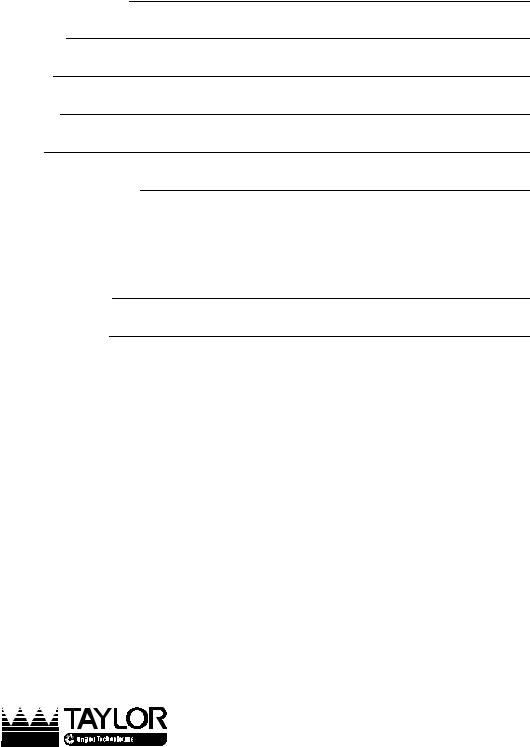
Complete this page for quick reference when service is required:
Taylor Distributor:
Address:
Phone:
Service:
Parts:
Date of Installation:
Information found on the data label:
Model Number:
Serial Number:
Electrical Specs: Voltage |
|
Cycle |
|||||
Phase |
|
|
|
|
|
||
Maximum Fuse Size: |
|
|
|
|
A |
||
Minimum Wire Ampacity: |
|
|
|
|
A |
||
E 2000 Carrier Commercial Refrigeration, Inc. 039709- M
Any unauthorized reproduction, disclosure, or distribution of copies by any person of any portion of this work may be a violation of Copyright Law of the United States of America and other countries, could result in the awarding of Statutory Damages of up to $250,000 (17 USC 504) for infringement, and may result in further civil and criminal penalties. All rights reserved.
Taylor Company
a division of Carrier Commercial Refrigeration, Inc. 750 N. Blackhawk Blvd.
Rockton, IL 61072

Table of Contents
Section 1 |
To the Installer . . . . . . . . . . . . . . . . . . . . . . . . . . . . . . . . . . . . . . . . . . . . |
1 |
Installer Safety . . . . . . . . . . . . . . . . . . . . . . . . . . . . . . . . . . . . . . . . . . . . . . . . . . . . . . . . |
1 |
|
Site Preparation . . . . . . . . . . . . . . . . . . . . . . . . . . . . . . . . . . . . . . . . . . . . . . . . . . . . . . . |
1 |
|
Air Cooled Units . . . . . . . . . . . . . . . . . . . . . . . . . . . . . . . . . . . . . . . . . . . . . . . . . . . . . . . |
1 |
|
Electrical Connections . . . . . . . . . . . . . . . . . . . . . . . . . . . . . . . . . . . . . . . . . . . . . . . . . |
2 |
|
Electrical Hookup Installation |
|
|
For 60 Cycle, 1 PH, Supplied With Cord and Plug . . . . . . . . . . . . . . . . . . . . . . . . . |
3 |
|
Refrigerant |
. . . . . . . . . . . . . . . . . . . . . . . . . . . . . . . . . . . . . . . . . . . . . . . . . . . . . . . . . . . |
3 |
Section 2 |
To the Operator . . . . . . . . . . . . . . . . . . . . . . . . . . . . . . . . . . . . . . . . . . . |
4 |
Section 3 |
Safety . . . . . . . . . . . . . . . . . . . . . . . . . . . . . . . . . . . . . . . . . . . . . . . . . . . . |
5 |
Section 4 |
Operator Parts Identification . . . . . . . . . . . . . . . . . . . . . . . . . . . . . . . |
7 |
Section 5 |
Important: To the Operator . . . . . . . . . . . . . . . . . . . . . . . . . . . . . . . . . |
8 |
Symbol Definitions . . . . . . . . . . . . . . . . . . . . . . . . . . . . . . . . . . . . . . . . . . . . . . . . . . . . |
8 |
|
Power Switch . . . . . . . . . . . . . . . . . . . . . . . . . . . . . . . . . . . . . . . . . . . . . . . . . . . . . . . . . |
8 |
|
Indicator Light - MIX LOW . . . . . . . . . . . . . . . . . . . . . . . . . . . . . . . . . . . . . . . . . . . . . |
8 |
|
Standby Switch . . . . . . . . . . . . . . . . . . . . . . . . . . . . . . . . . . . . . . . . . . . . . . . . . . . . . . . |
9 |
|
Reset Mechanism . . . . . . . . . . . . . . . . . . . . . . . . . . . . . . . . . . . . . . . . . . . . . . . . . . . . . |
9 |
|
Temperature Adjustments . . . . . . . . . . . . . . . . . . . . . . . . . . . . . . . . . . . . . . . . . . . . . . |
9 |
|
Feed Tube |
. . . . . . . . . . . . . . . . . . . . . . . . . . . . . . . . . . . . . . . . . . . . . . . . . . . . . . . . . . . |
9 |
Section 6 |
Operating Procedures . . . . . . . . . . . . . . . . . . . . . . . . . . . . . . . . . . . . . |
10 |
Assembly . |
. . . . . . . . . . . . . . . . . . . . . . . . . . . . . . . . . . . . . . . . . . . . . . . . . . . . . . . . . . . |
10 |
Sanitizing . |
. . . . . . . . . . . . . . . . . . . . . . . . . . . . . . . . . . . . . . . . . . . . . . . . . . . . . . . . . . . |
13 |
Priming . . . |
. . . . . . . . . . . . . . . . . . . . . . . . . . . . . . . . . . . . . . . . . . . . . . . . . . . . . . . . . . . |
15 |
Standby . . . |
. . . . . . . . . . . . . . . . . . . . . . . . . . . . . . . . . . . . . . . . . . . . . . . . . . . . . . . . . . . |
16 |
Closing Procedure . . . . . . . . . . . . . . . . . . . . . . . . . . . . . . . . . . . . . . . . . . . . . . . . . . . . |
16 |
|
Draining Product From the Freezing Cylinder . . . . . . . . . . . . . . . . . . . . . . . . . . . . . |
17 |
|
Rinsing . . . |
. . . . . . . . . . . . . . . . . . . . . . . . . . . . . . . . . . . . . . . . . . . . . . . . . . . . . . . . . . . |
17 |
Table of Contents |
Model 142 |

|
|
Table of Contents - Page 2 |
Cleaning . . |
. . . . . . . . . . . . . . . . . . . . . . . . . . . . . . . . . . . |
. . . . . . . . . . . . . . . . . . . . . . . . 17 |
Disassembly . . . . . . . . . . . . . . . . . . . . . . . . . . . . . . . . . . |
. . . . . . . . . . . . . . . . . . . . . . . . 17 |
|
Brush Cleaning . . . . . . . . . . . . . . . . . . . . . . . . . . . . . . . |
. . . . . . . . . . . . . . . . . . . . . . . . 18 |
|
Section 7 |
Important: Operator Checklist . . . . . . |
. . . . . . . . . . . . . . . . . . . . . . . . 19 |
During Cleaning and Sanitizing: . . . . . . . . . . . . . . . . . |
. . . . . . . . . . . . . . . . . . . . . . . . 19 |
|
Troubleshooting Bacterial Count: . . . . . . . . . . . . . . . . |
. . . . . . . . . . . . . . . . . . . . . . . . 19 |
|
Regular Maintenance Checks: . . . . . . . . . . . . . . . . . . |
. . . . . . . . . . . . . . . . . . . . . . . . 19 |
|
Winter Storage . . . . . . . . . . . . . . . . . . . . . . . . . . . . . . . . |
. . . . . . . . . . . . . . . . . . . . . . . . 20 |
|
Section 8 |
Troubleshooting Guide . . . . . . . . . . . . |
. . . . . . . . . . . . . . . . . . . . . . . . 21 |
Section 9 |
Parts Replacement Schedule . . . . . . . |
. . . . . . . . . . . . . . . . . . . . . . . . 23 |
Section 10 |
Limited Warranty on Equipment . . . . |
. . . . . . . . . . . . . . . . . . . . . . . . 24 |
Section 11 |
Limited Warranty on Parts . . . . . . . . . |
. . . . . . . . . . . . . . . . . . . . . . . . 26 |
Section 12 |
Parts List . . . . . . . . . . . . . . . . . . . . . . . . . |
. . . . . . . . . . . . . . . . . . . . . . . . 29 |
Wiring Diagram . . . . . . . . . . . . . . . . . . . . . . . . . . . . . . . |
. . . . . . . . . . . . . . . . . . . . . . . . 37 |
|
Note: Continuing research results in steady improvements; therefore, information in this manual is subject to change without notice.
Note: Only instructions originating from the factory or its authorized translation representative(s) are considered to be the original set of instructions.
E 2000 Carrier Commercial Refrigeration, Inc. (Original Publication) (Updated July, 2014)
039709- M
Any unauthorized reproduction, disclosure, or distribution of copies by any person of any portion of this work may be a violation of Copyright Law of the United States of America and other countries, could result in the awarding of Statutory Damages of up to $250,000 (17 USC 504) for infringement, and may result in further civil and criminal penalties. All rights reserved.
Taylor Company
a division of Carrier Commercial Refrigeration, Inc. 750 N. Blackhawk Blvd.
Rockton, IL 61072
Table of Contents |
Model 142 |

Section 1 |
To the Installer |
|
|
The following information has been included in the manual as safety and regulatory guidelines. For complete installation instructions, please see the Installation Checklist.
Installer Safety
 In all areas of the world, equipment should be installed in accordance with existing local codes. Please contact your local authorities if you have any questions.
In all areas of the world, equipment should be installed in accordance with existing local codes. Please contact your local authorities if you have any questions.
Care should be taken to ensure that all basic safety practices are followed during the installation and servicing activities related to the installation and service of Taylor equipment.
SOnly authorized Taylor service personnel should perform installation and repairs on the equipment.
SAuthorized service personnel should consult OSHA Standard 29CFRI910.147 or the applicable code of the local area for the industry standards on lockout/tagout procedures before beginning any installation or repairs.
SAuthorized service personnel must ensure that the proper PPE is available and worn when required during installation and service.
SAuthorized service personnel must remove all metal jewelry, rings, and watches before working on electrical equipment.
 The main power supply(s) to the freezer must be disconnected prior to performing any repairs. Failure to follow this instruction may result in personal injury or death from electrical shock or hazardous moving parts as well as poor performance or damage to the equipment.
The main power supply(s) to the freezer must be disconnected prior to performing any repairs. Failure to follow this instruction may result in personal injury or death from electrical shock or hazardous moving parts as well as poor performance or damage to the equipment.
Note: All repairs must be performed by an authorized Taylor Service Technician.
 This unit has many sharp edges that can cause severe injuries.
This unit has many sharp edges that can cause severe injuries.
Site Preparation
Review the area where the unit will be installed before uncrating the unit. Make sure all possible hazards to the user or the equipment have been addressed.
For Indoor Use Only: This unit is designed to operate indoors, under normal ambient temperatures of 70_-75_F (21_-24_C). The freezer has successfully performed in high ambient temperatures of 104_(40_C) at reduced capacities.
 This unit must NOT be installed in an area where a water jet or hose can be used. NEVER use a water jet or hose to rinse or clean the unit. Failure to follow this instruction may result in electrocution.
This unit must NOT be installed in an area where a water jet or hose can be used. NEVER use a water jet or hose to rinse or clean the unit. Failure to follow this instruction may result in electrocution.
 This unit must be installed on a level surface to avoid the hazard of tipping. Extreme care should be taken in moving this equipment for any reason. Two or more persons are required to safely move this unit. Failure to comply may result in personal injury or equipment damage.
This unit must be installed on a level surface to avoid the hazard of tipping. Extreme care should be taken in moving this equipment for any reason. Two or more persons are required to safely move this unit. Failure to comply may result in personal injury or equipment damage.
Uncrate the unit and inspect it for damage. Report any damage to your Taylor Distributor.
This piece of equipment is made in the USA and has USA sizes of hardware. All metric conversions are approximate and vary in size.
Air Cooled Units
DO NOT obstruct air intake and discharge openings:
Air cooled units require a minimum of 6” (152 mm) of clearance on both sides and 4” (102 mm) of clearance on the bottom of the freezer. To prevent warm exhaust from recirculating, place the rear of the unit against the wall. This will allow adequate air flow across the condenser.
|
|
131122 |
|
|
|
Model 142 |
1 |
To the Installer |
|
|
|
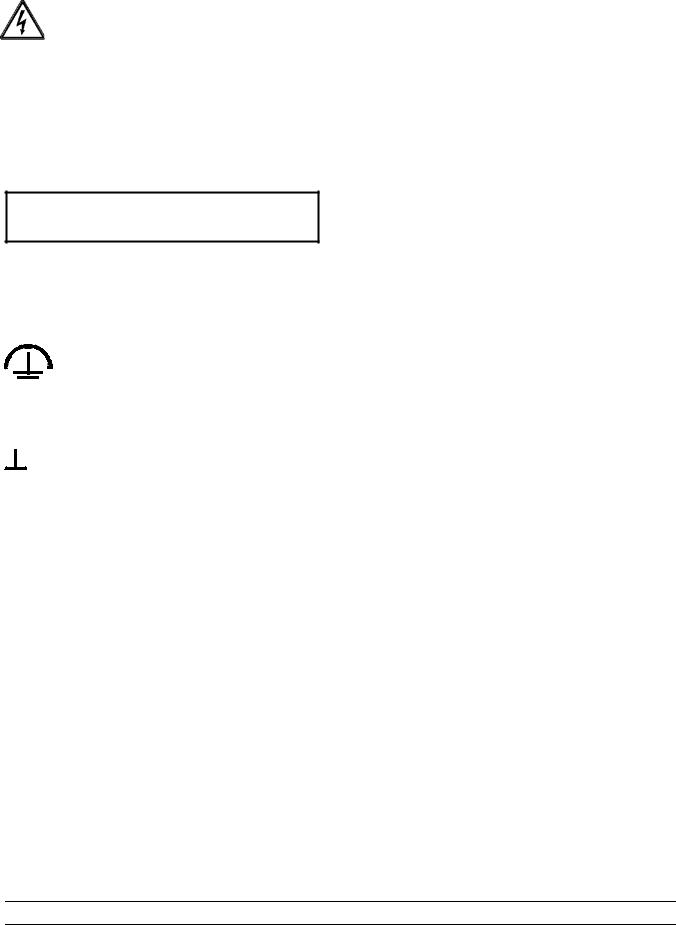
Electrical Connections
In the United States, this equipment is intended to be installed in accordance with the National Electrical Code (NEC), ANSI/NFPA 70-1987. The purpose of the NEC code is the practical safeguarding of persons and property from hazards arising from the use of electricity. This code contains provisions considered necessary for safety. In all other areas of the world, equipment should be installed in accordance with the existing local codes. Please contact your local authorities.
FOLLOW YOUR LOCAL ELECTRICAL CODES!
Each unit requires one power supply for each data label on the unit. Check the data label(s) on the freezer for branch circuit overcurrent protection or fuse, circuit ampacity, and other electrical specifications. Refer to the wiring diagram provided inside of the electrical box for proper power connections.
 CAUTION: THIS EQUIPMENT MUST BE PROPERLY GROUNDED! FAILURE TO DO SO CAN RESULT IN SEVERE PERSONAL INJURY FROM ELECTRICAL SHOCK!
CAUTION: THIS EQUIPMENT MUST BE PROPERLY GROUNDED! FAILURE TO DO SO CAN RESULT IN SEVERE PERSONAL INJURY FROM ELECTRICAL SHOCK!
 This unit is provided with an equipotential grounding lug that is to be properly attached to the rear of the frame by the authorized installer. The installation location is marked by the equipotential bonding symbol (5021 of IEC 60417-1) on both the removable panel and the equipment’s frame.
This unit is provided with an equipotential grounding lug that is to be properly attached to the rear of the frame by the authorized installer. The installation location is marked by the equipotential bonding symbol (5021 of IEC 60417-1) on both the removable panel and the equipment’s frame.
SStationary appliances which are not equipped with a power cord and a plug or another device to disconnect the appliance from the power source must have an all-pole disconnecting device with a contact gap of at least 3 mm installed in the external installation.
SAppliances that are permanently connected to fixed wiring and for which leakage currents may exceed 10 mA, particularly when disconnected, not used for long periods, or during initial installation, shall have protective devices such as a GFI to protect against the leakage of current, installed by authorized personnel to the local codes.
SSupply cords used with this unit shall be oil-resistant, sheathed flexible cable, not lighter than ordinary polychloroprene or other equivalent synthetic elastomer-sheathed cord (Code designation 60245 IEC 57) installed with the proper cord anchorage to relieve conductors from strain, including twisting, at the terminals and protect the insulation of the conductors from abrasion.
If the supply cord is damaged, it must be replaced by the manufacturer, its service agent, or similarly qualified person, in order to avoid a hazard.
101111
To the Installer 2 Model 142
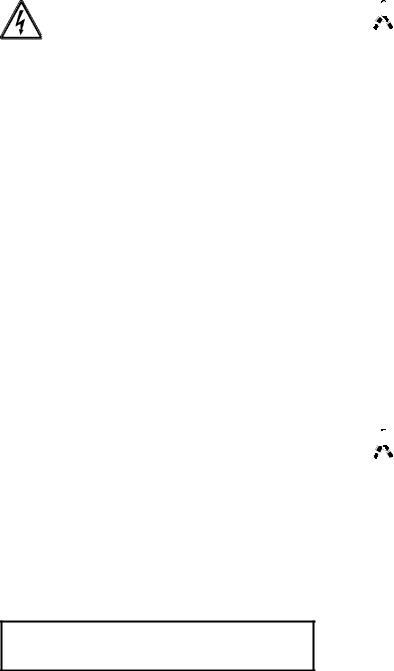
Electrical Hookup Installation
For 60 Cycle, 1 PH, Supplied With Cord and Plug
This equipment is supplied with a 3- wire cord and grounding type plug for connection to a single phase, 60 cycle, branch circuit supply. This unit must be plugged into a properly grounded receptacle. The cord and plug provided for 115/60/1 and 208230/60/1 is 15 amp.; therefore the wall outlet must also be 15 amp. Check the data label located on the rear of the freezer for electrical specifications.
IMPORTANT: In order to secure the compressor and to minimize vibration during shipment, two shipping bolts have been added to the base pan of the unit. Before installation, these bolts must be removed.
Permanent wiring may be used if local codes require it. Instructions for conversion to permanent wiring are as follows:
 IMPORTANT: This procedure must be performed by a qualified electrician.
IMPORTANT: This procedure must be performed by a qualified electrician.
1.Be sure the freezer is electrically disconnected.
2.Remove the appropriate panel and locate the control box at the back of the freezer.
3.Remove the factoryinstalled cord and strain relief bushing.
4.Route incoming permanent wiring through 7/8” (22 mm) hole in base pan.
5.Connect two power supply leads, attach ground (earth) wire to the grounding lug inside the electrical box.
6.Be sure unit is properly grounded before applying power.
FOLLOW YOUR LOCAL ELECTRICAL CODES!
Refrigerant
 In consideration of our environment, Taylor uses only earth friendly HFC refrigerants. The HFC refrigerant used in this unit is R404A. This refrigerant is generally considered non-toxic and non-flammable, with an Ozone Depleting Potential (ODP) of zero (0).
In consideration of our environment, Taylor uses only earth friendly HFC refrigerants. The HFC refrigerant used in this unit is R404A. This refrigerant is generally considered non-toxic and non-flammable, with an Ozone Depleting Potential (ODP) of zero (0).
However, any gas under pressure is potentially hazardous and must be handled with caution. NEVER fill any refrigerant cylinder completely with liquid. Filling the cylinder to approximately 80% will allow for normal expansion.
 Use only R404A refrigerant that conforms to the AHRI standard 700 specification. The use of any other refrigerant may expose users and operators to unexpected safety hazards.
Use only R404A refrigerant that conforms to the AHRI standard 700 specification. The use of any other refrigerant may expose users and operators to unexpected safety hazards.
 Refrigerant liquid sprayed onto the skin may cause serious damage to tissue. Keep eyes and skin protected. If refrigerant burns should occur, flush immediately with cold water. If burns are severe, apply ice packs and contact a physician immediately.
Refrigerant liquid sprayed onto the skin may cause serious damage to tissue. Keep eyes and skin protected. If refrigerant burns should occur, flush immediately with cold water. If burns are severe, apply ice packs and contact a physician immediately.
 Taylor reminds technicians to be cautious of government laws regarding refrigerant recovery, recycling, and reclaiming systems. If you have any questions regarding these laws, please contact the factory Service Department.
Taylor reminds technicians to be cautious of government laws regarding refrigerant recovery, recycling, and reclaiming systems. If you have any questions regarding these laws, please contact the factory Service Department.
 WARNING: R404A refrigerant used in conjunction with polyolester oils is extremely moisture absorbent. When opening a refrigeration system, the maximum time the system is open must not exceed 15 minutes. Cap all open tubing to prevent humid air or water from being absorbed by the oil.
WARNING: R404A refrigerant used in conjunction with polyolester oils is extremely moisture absorbent. When opening a refrigeration system, the maximum time the system is open must not exceed 15 minutes. Cap all open tubing to prevent humid air or water from being absorbed by the oil.
|
|
130809 |
|
|
|
Model 142 |
3 |
To the Installer |
|
|
|

Section 2 |
To the Operator |
|
|
Your freezer has been carefully engineered and manufactured to give you dependable operation. If the Taylor Model 142 is properly operated and cared for, it will produce a consistent, quality product. Like all mechanical products, this machine will require cleaning and maintenance. A minimum amount of care is necessary if the operating procedures outlined in this manual are followed closely.
 This Operator’s Manual should be read before operating or performing any maintenance on your equipment.
This Operator’s Manual should be read before operating or performing any maintenance on your equipment.
Your Taylor freezer will NOT eventually compensate and correct for any errors during the setup or filling operations. Thus, the initial assembly and priming procedures are of extreme importance. It is important that the personnel responsible for the equipment’s operation study this manual in order to be properly trained.
In the event you should require technical assistance, please contact your local authorized Taylor Distributor.
Note: Your Taylor warranty is valid only if the parts are authorized Taylor parts, purchased from the local authorized Taylor Distributor, and only if all required service work is provided by an authorized Taylor service technician. Taylor reserves the right to deny warranty claims on units or parts if nonTaylor approved parts or incorrect refrigerant were installed in the unit, system modifications were performed beyond factory recommendations, or it is determined that the failure was caused by abuse, misuse, neglect, or failure to follow all operating instructions. For full details of your Taylor Warranty, please see the Limited Warranty section in this manual.
Note: Constant research results in steady improvements; therefore, information in this manual is subject to change without notice.
 If the crossed out wheeled bin symbol is affixed to this product, it signifies that this product is compliant with the EU Directive as well as other similar legislation in effect after August 13, 2005. Therefore, it must be collected separately after its use is completed, and cannot be disposed as unsorted
If the crossed out wheeled bin symbol is affixed to this product, it signifies that this product is compliant with the EU Directive as well as other similar legislation in effect after August 13, 2005. Therefore, it must be collected separately after its use is completed, and cannot be disposed as unsorted
municipal waste. The user is responsible for returning the product to the appropriate collection facility, as specified by your local code.
For additional information regarding applicable local laws, please contact the municipal facility and/or local distributor.
Compressor Warranty Disclaimer
The refrigeration compressor(s) on this unit are warranted for the term stated in the Limited Warranty section in this manual. However, due to the Montreal Protocol and the U.S. Clean Air Act Amendments of 1990, many new refrigerants are being tested and developed, thus seeking their way into the service industry. Some of these new refrigerants are being advertised as dropin replacements for numerous applications. It should be noted that in the event of ordinary service to this unit’s refrigeration system, only the refrigerant specified on the affixed data label should be used. The unauthorized use of alternate refrigerants will void your Taylor compressor warranty. It is the unit owner’s responsibility to make this fact known to any technician he employs.
It should also be noted that Taylor does not warrant the refrigerant used in its equipment. For example, if the refrigerant is lost during the course of ordinary service to this machine, Taylor has no obligation to either supply or provide its replacement either at billable or unbillable terms. Taylor does have the obligation to recommend a suitable replacement if the original refrigerant is banned, obsoleted, or no longer available during the five year warranty of the compressor.
Taylor will continue to monitor the industry and test new alternates as they are being developed. Should a new alternate prove, through our testing, that it would be accepted as a dropin replacement, then the above disclaimer would become null and void. To find out the current status of an alternate refrigerant as it relates to your compressor warranty, call the local Taylor Distributor or the Taylor Factory. Be prepared to provide the Model/Serial Number of the unit in question.
131122
To the Operator 4 Model 142

Section 3 |
Safety |
|
|
We, at Taylor Company, are concerned about the safety of the operator when he or she comes in contact with the freezer and its parts. Taylor has gone to extreme efforts to design and manufacture builtin safety features to protect both you and the service technician. As an example, warning labels have been attached to the freezer to further point out safety precautions to the operator.
 IMPORTANT - Failure to adhere to the following safety precautions may result in severe personal injury or death. Failure to comply with these warnings may damage the machine and its components. Component damage will result in part replacement expense and service repair expense.
IMPORTANT - Failure to adhere to the following safety precautions may result in severe personal injury or death. Failure to comply with these warnings may damage the machine and its components. Component damage will result in part replacement expense and service repair expense.
 DO NOT operate the freezer without reading this Operator Manual. Failure to follow this instruction may result in equipment damage, poor freezer performance, health hazards, or personal injury.
DO NOT operate the freezer without reading this Operator Manual. Failure to follow this instruction may result in equipment damage, poor freezer performance, health hazards, or personal injury.
 This appliance is to be used only by trained personnel. It is not intended for use by children or people with reduced physical, sensory, or mental capabilities, or lack of experience and knowledge, unless given supervision or instruction concerning the use of the appliance by a person responsible for their safety. Children should be supervised to ensure that they do not play with the appliance.
This appliance is to be used only by trained personnel. It is not intended for use by children or people with reduced physical, sensory, or mental capabilities, or lack of experience and knowledge, unless given supervision or instruction concerning the use of the appliance by a person responsible for their safety. Children should be supervised to ensure that they do not play with the appliance.
 This unit is provided with an equipotential grounding lug that is to be properly attached to the rear of the frame by the authorized installer. The installation location is marked by the equipotential bonding symbol (5021 of IEC 60417-1) on both the removable panel and the equipment’s frame.
This unit is provided with an equipotential grounding lug that is to be properly attached to the rear of the frame by the authorized installer. The installation location is marked by the equipotential bonding symbol (5021 of IEC 60417-1) on both the removable panel and the equipment’s frame.
 DO NOT use a water jet to clean or rinse the freezer. Failure to follow these instructions may result in serious electrical shock.
DO NOT use a water jet to clean or rinse the freezer. Failure to follow these instructions may result in serious electrical shock.
SDO NOT operate the freezer unless it is properly grounded.
SDO NOT operate the freezer with larger fuses than specified on the freezer data label.
SAll repairs must be performed by an authorized Taylor service technician.
SThe main power supplies to the machine must be disconnected prior to performing any repairs.
SFor Cord Connected Units: Only Taylor authorized service technicians or licensed electricians may install a plug or replacement cord on these units.
SStationary appliances which are not equipped with a power cord and a plug or another device to disconnect the appliance from the power source must have an all-pole disconnecting device with a contact gap of at least 3 mm installed in the external installation.
SAppliances that are permanently connected to fixed wiring and for which leakage currents may exceed 10 mA, particularly when disconnected, not used for long periods, or during initial installation, shall have protective devices such as a GFI to protect against the leakage of current, installed by authorized personnel to the local codes.
SSupply cords used with this unit shall be oil-resistant, sheathed flexible cable, not lighter than ordinary polychloroprene or other equivalent synthetic elastomer-sheathed cord (Code designation 60245 IEC 57) installed with the proper cord anchorage to relieve conductors from strain, including twisting, at the terminals and protect the insulation of the conductors from abrasion.
If the supply cord is damaged, it must be replaced by the manufacturer, its service agent, or similarly qualified person, in order to avoid a hazard.
Failure to follow these instructions may result in electrocution. Contact your local authorized Taylor Distributor for service.
|
|
130211 |
|
|
|
Model 142 |
5 |
Safety |
|
|
|
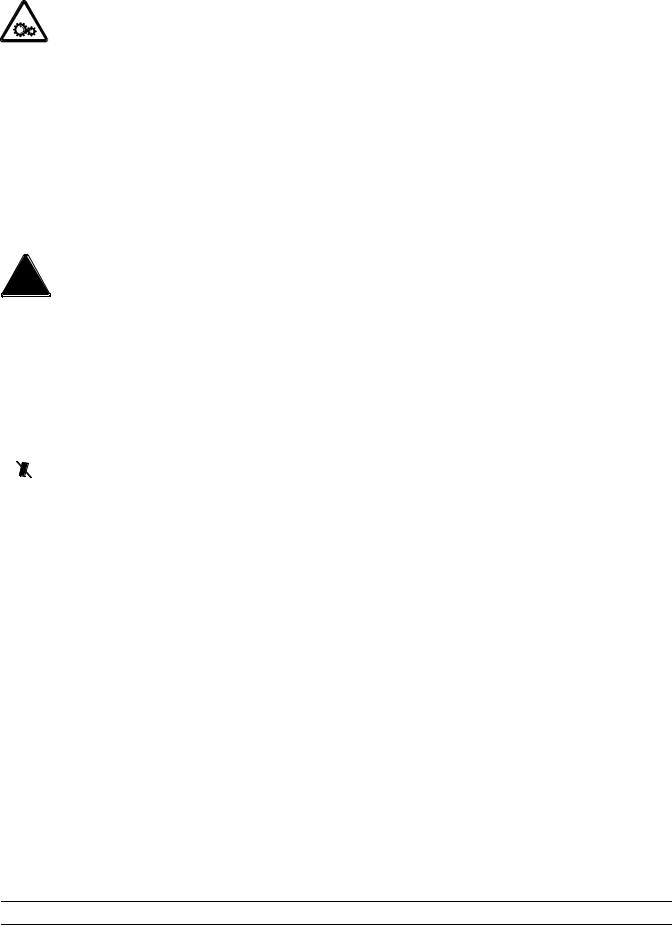
SDO NOT allow untrained personnel to operate this machine.
SDO NOT operate the freezer unless all service panels and access doors are restrained with screws.
SDO NOT remove any internal operating parts (examples: freezer door, beater, scraper blades, etc.) unless all control switches are in the OFF position.
Failure to follow these instructions may result in severe personal injury to fingers or hands from hazardous moving parts.
 This unit has many sharp edges that can cause severe injuries.
This unit has many sharp edges that can cause severe injuries.
SDO NOT put objects or fingers in the door spout. This may contaminate the product and cause severe personal injury from blade contact.
SUSE EXTREME CAUTION when removing the beater asssembly. The scraper blades are very sharp.
 This unit must be placed on a level surface. Failure to comply may result in personal injury or equipment damage.
This unit must be placed on a level surface. Failure to comply may result in personal injury or equipment damage.
 Access to the service area of the unit is restricted to persons having knowledge and practical experience with the appliance, in particular as far as safety and hygiene are concerned.
Access to the service area of the unit is restricted to persons having knowledge and practical experience with the appliance, in particular as far as safety and hygiene are concerned.
 Cleaning and sanitizing schedules are governed by your state or local regulatory agencies and must be followed accordingly. Please refer to the cleaning section of this manual for the proper procedure to clean this unit.
Cleaning and sanitizing schedules are governed by your state or local regulatory agencies and must be followed accordingly. Please refer to the cleaning section of this manual for the proper procedure to clean this unit.
 This unit is designed to maintain product temperature under 41_F (5_C). Any product being added to this machine must be below 41_F (5_C). Failure to follow this instruction may result in health hazards and poor freezer performance.
This unit is designed to maintain product temperature under 41_F (5_C). Any product being added to this machine must be below 41_F (5_C). Failure to follow this instruction may result in health hazards and poor freezer performance.
DO NOT obstruct air intake and discharge openings:
6” (152 mm) minimum air space on sides and rear, and 4” (102 mm) minimum on bottom. Failure to follow this instruction may cause poor freezer performance and damage to the machine.
For Indoor Use Only: This unit is designed to operate indoors, under normal ambient temperatures of 70_ - 75_F (21_ - 24_C). The freezer has successfully performed in high ambient temperatures of 104_F (40_C) at reduced capacities.
DO NOT run the unit without product. Failure to follow this instruction can result in damage to the unit.
NOISE LEVEL: Airborne noise emission does not exceed 78 dB(A) when measured at a distance of 1.0 meter from the surface of the machine and at a height of 1.6 meters from the floor.
130211
Safety 6 Model 142
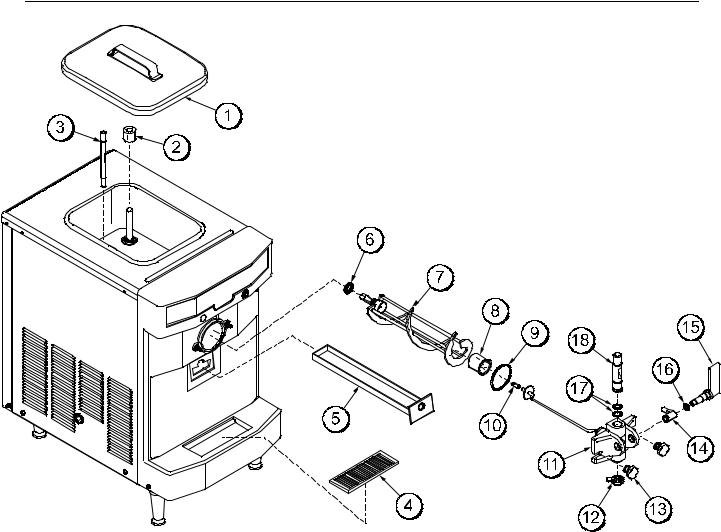
Section 4 Operator Parts Identification
ITEM |
DESCRIPTION |
PART NO. |
|
|
|
1 |
COVER A.- HOPPER |
X49633 |
|
|
|
2 |
FLOAT A.- MIX LEVEL |
X39690 |
|
|
|
3 |
TUBE- FEED- .166 HOLESS |
035819 |
|
|
|
4 |
SHIELDSPLASHPLASTIC |
039444 |
|
|
|
5 |
PAN A.- WHITE FRONT DRIP |
X43474 |
|
|
|
6 |
SEAL- U- CUP |
080534 |
|
|
|
7 |
BEATER A. |
X24689 |
|
|
|
8 |
BEARINGFRONT |
023262 |
|
|
|
9 |
O- RING- 2- 3/4 OD X .139W |
019998 |
|
|
|
ITEM |
DESCRIPTION |
PART NO. |
|
|
|
10 |
BEARINGGUIDE |
014496 |
|
|
|
11 |
DOOR A.- PARTIAL- 1 SPOUT |
X38959SER |
|
|
|
12 |
CAPDESIGN 1.010”ID- 6 PT |
014218 |
|
|
|
13 |
NUTSTUD |
034829 |
|
|
|
14 |
ARMVALVE LIFTER |
024761 |
|
|
|
15 |
HANDLEDRAW |
024762 |
|
|
|
16 |
O- RING- 3/4 OD X .103W |
015835 |
|
|
|
17 |
O- RING- 7/8 OD X .103W |
014402 |
|
|
|
18 |
VALVEDRAW |
024763 |
|
|
|
|
|
140407 |
|
|
|
Model 142 |
7 |
Operator Parts Identification |
|
|
|

Section 5 |
Important: To the Operator |
|||||||||||||||||||||||||||
|
|
|
|
|
|
|
|
|
|
|
|
|
|
|
|
|
|
|
|
|
|
|
|
|
|
|
|
|
|
|
|
|
|
|
|
|
|
|
|
|
|
|
|
|
|
|
|
|
|
|
|
|
|
|
|
|
|
|
|
|
|
|
|
|
|
|
|
|
|
|
|
|
|
|
|
|
|
|
|
|
|
|
|
|
|
|
|
|
|
|
|
|
|
|
|
|
|
|
|
|
|
|
|
|
|
|
|
|
|
|
|
|
|
|
|
|
|
|
|
|
|
|
|
|
|
|
|
|
|
|
|
|
|
|
|
|
|
|
|
|
|
|
|
|
|
|
|
|
|
|
|
|
|
|
|
|
|
|
|
|
|
|
|
|
|
|
|
|
|
|
|
|
|
|
|
|
|
|
|
|
|
|
|
|
|
|
|
|
|
|
|
|
|
|
|
|
|
|
|
|
|
|
|
|
|
|
|
|
|
|
|
|
|
|
|
|
|
|
|
|
|
|
|
|
|
|
|
|
|
|
|
|
|
|
|
|
|
|
|
|
|
|
|
|
|
|
|
|
|
|
|
|
|
|
|
|
|
|
|
|
|
|
|
|
|
|
|
|
|
|
|
|
|
|
|
|
|
|
|
|
|
|
|
|
|
|
|
|
|
|
|
|
|
|
|
|
|
|
|
|
|
|
|
|
|
|
|
|
|
|
|
|
|
|
|
|
|
|
|
|
|
|
|
|
|
|
|
|
|
|
|
|
|
|
|
|
|
|
|
|
|
|
|
|
|
|
|
|
|
|
|
|
|
|
|
|
|
|
|
|
|
|
|
|
|
|
|
|
|
|
|
|
|
|
|
|
|
|
|
|
|
|
|
|
|
|
|
|
|
|
|
|
|
|
|
|
|
|
|
|
|
|
|
|
|
|
|
|
|
|
|
|
|
|
|
|
|
|
|
|
|
|
|
|
|
|
|
|
|
|
|
|
|
|
|
|
|
|
|
|
|
|
|
|
|
|
|
|
|
|
|
|
|
|
|
|
|
|
|
|
|
|
|
|
|
|
|
|
|
|
|
|
|
|
|
|
|
|
|
|
|
|
|
|
|
|
|
|
|
|
|
|
|
|
|
|
|
|
|
|
|
|
|
|
|
|
|
|
|
|
|
|
|
|
|
|
|
|
|
|
|
|
|
|
|
|
|
|
|
|
|
|
|
|
|
|
|
|
|
|
|
|
|
|
|
|
|
|
|
|
|
|
|
|
|
|
|
|
|
|
|
|
|
|
|
|
|
|
|
|
|
|
|
|
|
|
|
|
|
Figure 1
ITEM |
DESCRIPTION |
|
|
1 |
Power Switch |
2 |
Indicator Light - MIX LOW |
|
|
3 |
Standby Switch |
|
|
Symbol Definitions
To better communicate in the International arena, the words on many of our operator switches and buttons have symbols to indicate their functions. Your Taylor equipment is designed with these International symbols.
The following chart identifies the symbol definitions used on the operator switches.
= ON/AUTO
= OFF
= WASH
Power Switch
The center position is the OFF position. The left position is WASH which activates the beater motor only. The right position is the AUTO position, which activates the beater motor and the refrigeration.
Indicator Light - MIX LOW
A mix level indicating light is located on the front of the machine. When the light is on, it indicates that the mix hopper has a low supply of mix. The hopper should be refilled immediately. Always maintain at least 2” (5.1 cm.) of mix in the hopper. If mix is not added to the hopper, the freezing cylinder may freeze. This will cause damage to the beater assembly and to the freezer door.
Important: To the Operator |
8 |
Model 142 |
|
|
|

Standby Switch
This push button switch determines which mode of operation the freezing cylinder is operating in. If the center button of this switch is in the “OUT” position and it is not illuminated, the unit will operate in the normal product dispensing mode when the toggle switch is placed in the AUTO position.
If the center button of the standby switch is in the “IN” position and is illuminated, the machine will operate in the STANDBY mode when the toggle switch is placed in the AUTO position.
Reset Mechanism
Should an overload condition occur, the freezer will automatically shut down. To properly reset the freezer, place the toggle switch in the OFF position. Wait two or three minutes; then press the reset button located in the side panel. Place the toggle switch in the WASH position and observe the freezer’s performance; return the toggle switch to the AUTO position.
Temperature Adjustments
Temperature adjustments should be performed only by an authorized Taylor Service Representative.
Feed Tube
The feed tube meters a combination of mix and air into the freezing cylinder. If mix is not added to the hopper, the freezing cylinder may freeze. This will cause damage to the beater assembly and to the freezer door. Depending upon the product being run, you may wish to contact your local authorized Taylor Distributor to make a slight adjustment in the feed tube.
One end of the feed tube has a metering hole in the side and the other end does not.
Figure 2
When the unit is operating in the AUTO mode, the metering hole should be placed in the downward position.
Figure 3
When the unit is placed in the STANDBY mode, the feed tube is inverted so the end without the metering hole is placed in the downward position.
Figure 4
Note: Make sure the level of mix is below the metering hole in the side of the feed tube. Failure to follow this instruction may result in lower product quality when normal operation is resumed.
|
|
130702 |
|
|
|
Model 142 |
9 |
Important: To the Operator |
|
|
|
